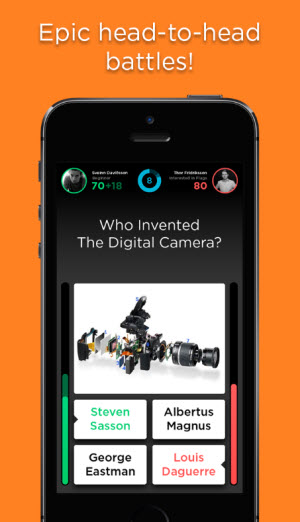Question: If games that have that kind of social competition aspect become sticky, why doesn’t the quiz game genre move up and stick around?
Birnbryer: The first reason that jumps out at me is that in a quiz game, someone always loses. Someone walks away not feeling as smart. It’s fun to be the one that’s winning, but when you lose to your friends, you think, “This sucks. I don’t want to play.”
I’ve been playing a lot of QuizUp, and the other person always drops out halfway through. “Partner has left the game.” Because they think, “I’m gonna lose. I’m done.” Nobody likes that. So if you have that aspect where you possibly feel not quite as smart at the end, that’s tough to get past.
Also, I’d look at the monetization aspect. You need the right payment walls in the game. Some games do that very well. They get you hooked. You feel like it’s fun. Then you feel like, “Oh, here’s a cool new feature.” Clash of Clans adds new characters you have to buy. A game like QuizUp, what are they going to give you that you want to spend money on?
GamesBeat: Family Feud-style games, it seems like, might be more suitable toward retaining audiences. You’re not asking for someone’s level of trivia knowledge or how much they know about sports. You’re asking whether they can accurately guess the results of a survey, which doesn’t take special knowledge.
Peng: One thing with quiz games, like Words With Friends and other games like that, it’s a bit of a novelty. It was fun back then, but for me, it lost its spark. Games like that rise quickly in the ranks and gain a lot of visibility, but the monetization factor is tough. You don’t see Words With Friends as a number one grossing game. They may get a lot of virality and a lot of user base, but there’s not a lot of motivation to pay money to beat the other guy or whatever the mechanic is. I have trouble seeing that as a big grossing area.
Question: What do you think is the best push message you can send to a user to bring them back into your app?
Birnbryer: Have it be pertinent to the game. Have it be something that’s going to catch my eye. Have something fun. You don’t want it to be spammy. You don’t want it to happen too often. I turn off push notifications when I get them multiple times a day. But how about, “Just so you know, this new feature just got rolled out. Come check it out”? Or, “Hey, we just added this for you.” Or, “Hey, we missed you. Here’s a free life.”
Give me a little something that makes me think, “Oh, I forgot I was doing this,” instead of just, “Hey, haven’t seen you in a while.” That’s the most common one. It’s just your app being needy. Gimme my space. But if you say, “Hey, we got this cool thing that everyone else loves,” all right, I gotta go check it out.
Bruch: One thing we’ve seen work with some of our partners is giving users something special. If it’s an app where you need currency to advance in a level, maybe you give them a couple extra tokens or whatever. Maybe they’ll want to buy more at some point. We’ve seen that do well.
Personalization is a huge thing too. If the user feels like you recognize them as someone who’s important to the game, that tends to work well. If it’s a blanket statement, they can read through that. You’re generally not going to have as much success.
Peng: I personally like the notes that have a little utility, like in Clash of Clans. Your troops are ready, or some person attacked you. Another way to look at it is, you can offer an incentive, but the way I would value it is, what’s the cost of re-engaging? What would you have to spend otherwise to share some kind of virality for less than that?
Question: Do you see programmatic media, self-organizing creative, and retargeting starting to take over the space? Is it becoming more prominent?
Birnbryer: I do think it’s important. As time has told us, the more you can put on to an automated path — look at building cars. We used to build them by hand. It got better when we started doing it on a conveyor belt. A lot of different aspects could benefit from that.
Like Dean said earlier, this isn’t a science. There is a bit of art to it. You have to have that personal touch to fine-tune it. But any way you can build up your database and know that, based on 1,000 campaigns, A creative is better than B creative, then great. When I reach out and start a campaign, I’m going to start with A, because they have a better likelihood of doing it well. You have to have some aspect of that in play. You can’t turn it down.
Programmatic is becoming very important. Right now, it’s still a small component of the market in general. You have to have that personal touch. But you should be doing as much A-B testing as you possibly can. That’s the only way you can know what works and what doesn’t. You can have 10 different creatives, 10 different traffic sources, and if you’re just running them and getting a big pool of conversions, great. You’re getting users, but you don’t have anything else.
You should collect as much data as possible. That’s what we try to do when we’re doing our LTV optimization for our clients. Give us all the data we can possibly can and let us utilize that to find the right user for you. We’ll let you know what’s better than this or that.
Question: Speaking of finding the right user, Facebook knows so much about our customers, targeting specific interests and demographics — everything we’ve tried in addition to that hasn’t worked out. We want it to work out, because Facebook is also a bidding madhouse where we’re bidding against our competitors and prices go through the roof every time we try to increase volume. How are you guys addressing the need to target specific demographics and psychographics for the advertiser?
Bruch: Publishers Clearing House has data on 100 million Americans that have come through our system. While you think about Facebook as a publisher that obviously has a lot of data, there are other publishers out there that have a tremendous amount of data as well. We’re one of them. There are a bunch more that set the space. You can move outside of Facebook.
Where the discussion started, Facebook is the primary driver, and people focus most of their UA efforts there. But on the fringe there’s going to be a lot more players coming into the space that have first-party data and lots of it. They might not have been a household name before, but they can drive a lot of value. If you’re looking for a user that is male, under the age of 25, that lives in a specific zip code, we can provide that for you, and others out there can do that too.
Peng: Facebook, right now, is one of the most powerful targeting tools out there, but that’s changing a lot. A lot more options are becoming available to the public. Google is giving users a lot more products that use those targeting capabilities, that leverage the data. Vendors like Amazon are entering the space. A lot of vendors are just becoming more transparent. When you buy across exchanges on DSP, you can start to leverage a lot of data sources to enrich the users that you’re targeting.
Month over month, year over year, these new capabilities and channels are becoming more viable and more available. Facebook isn’t going to be the end-all be-all. There are going to be new competitors in the space you’ll be able to buy through.



